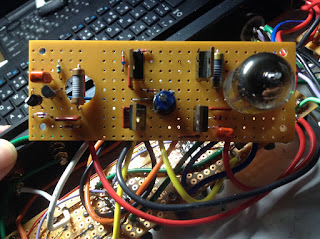This is Pioneer's model PL-1100, purchased about 40 years ago, direct drive turn table, still possible to work.
I want to modify the motor drive circuit using DC power amp.
I want to modify the motor drive circuit using DC power amp.
The motor coils equip 3 hall elements. The set of coil consists of totally 24 wound (8 wound per phase).
Below is the experimental circuit, which consists of sensor amp, gain controller and motor amp.
The gain controller is LM13700N (trans-conductance amplifier IC). The motor amp is half signal because of experimental purpose.
Below is simulation result which shows plot of current signal flows load resistor. 4 different level of half sine curves are obtained by stepping control signal for LM13700N. This circuit should control the motor torque and result in controlling the rotation of the speed.
Blow is the another simulation plot made by the same 3 circuits. 120 degree phase different signals are given to the sensors. This set of 3 motor drive current should generate continuous rotational magnetic field for the motor.
Below is measured signals of position sensor output when the motor is turned by hand. The shape of the waves are far from sin curves, but this is the signal from the hall sensor. The power supply to the hall sensor is -5V/+5V instead of originally supplied with 0/+18V.
Below is circuit board for power amp to drive the motor coil. (This power amp is for experimental purpose)
The next step is to make speed control circuit. The reference is Motor Control Amplifier for SP-10MK1 designed by A. Kaneta. Reference pulse signal (or clock signal) at 88.88Hz is obtained from 2.4579MHz X'tal oscillator with two digital divider; 512 and 54.
Below is circuit board made for the reference pulse generator and rotation speed signal feedback control.
Below time chart plots speed sensor signal pulse (blue) and control output (orange) during start up of the rotation. The control output shows tendency of hunting before reaching rated speed. Driving power of the power amp may be insufficient.
Next is to replace the power amp circuit with DC power amps, which should make the sound even greater.
Below is the power amp circuit. Final stage transistors are 2N3055 which consist of SEPP. Driver transistors are 2SA606 with simple connection to the 2N3055. This is typical DC power amp circuit known as 'Full symmetric circuit' named by Mr. Kaneta)
3 sets of the power amp circuit boards were made to built in the turn table box. The power source fot the power amp is battery.
Driving torque with DC power amp is powerful. The turn table accelerates much faster. The platter starts and reaches at its rated speed within one forth of a rotation. The speed feed back gain was a bit relaxed to obtain smoother control output as shown the plot below.
Neon lamp bulb was replaced with red LED.
The battery for the power amp source is supplied by two Li-po batteris (2100mAh 3cell at 11.1V/each)
The sound from the record is remarkable. Solo play tone in violin concert is very smooth and impressible. Piano tone is also vivid as if it performes live.
(2017)




























